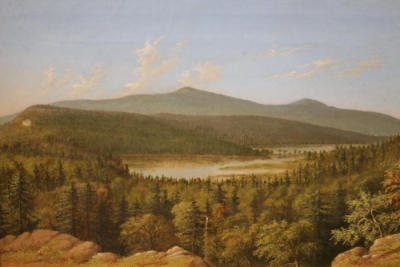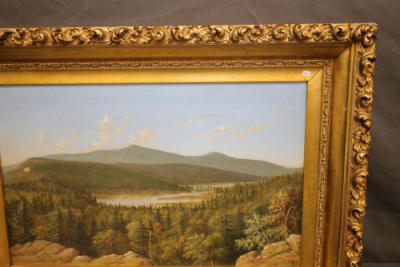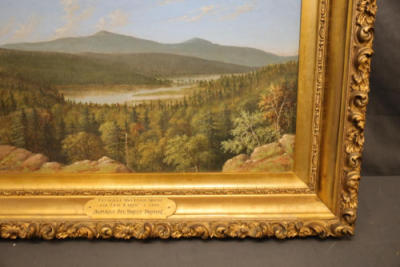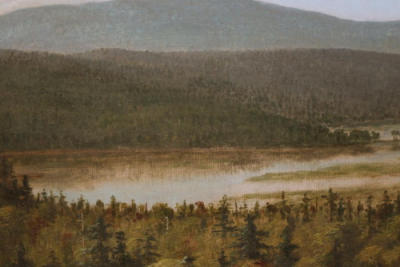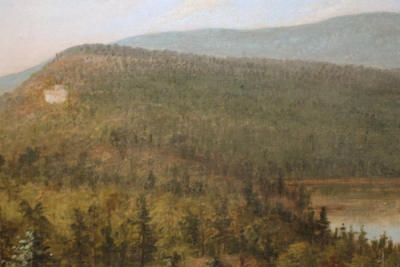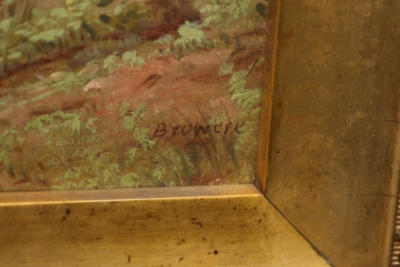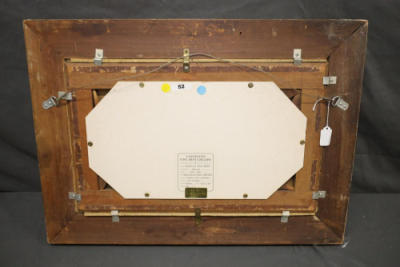This curated auction of Hudson River Paintings for sale is from the personal collection of Robert & Susan Doyle of Fishkill, NY. The Doyle's are offering thirty-seven American 19thC Hudson River School paintings at auction. All Hudson River paintings in this sale are original works and almost all have been professionally cleaned and conserved. The first American School of Art is known as "The Hudson River School," consisting of mid nineteenth century "Nature Painters" who found spirituality in nature. These adventuresome Hudson River artists hiked to see impressive views. They sketched and did studies in the field to bring back to their studios to create finished paintings. The Hudson River served as the main route of travel to the best places, as well as provided the best subject matter. New York City, with the National Academy of Design to exhibit at, was the center of the American Arts world in the 19thC. These "Nature Painters" celebrated and depicted the pristine magnificence of the American landscape of the 19th Century on their canvases. Now you can experience the beauty, tranquility and grandness of Nature from the first American School of Art; the Hudson River School. Register and Bid now! Artwork is on display at the Absolute Auction Center in Pleasant Valley, NY.
Payment is due by Friday, December 13 at 1PM. All lots subject to seller approval.
Information with payment and pickup instructions will be emailed to winning bidders the morning after the auction ends.
Pickup is by appointment only and must be completed by Friday, December 13 at 3PM.
All lots sold as is, where is. There is a 18% Buyers Premium for all lots purchased. Payment methods for non-vehicle & non-equipment is cash, Visa, Master Card or Discover card.
Preview available online 24 hours or by appointment only. To schedule, contact our office at 845-635-3169, option 7.
Items are located at the Absolute Auction Center: 45 South Ave, Pleasant Valley, NY 12569.
Click More Info/Bid Now for additional photos.
Payment is due by Friday, December 13 at 1PM. All lots subject to seller approval.
Information with payment and pickup instructions will be emailed to winning bidders the morning after the auction ends.
Pickup is by appointment only and must be completed by Friday, December 13 at 3PM.
All lots sold as is, where is. There is a 18% Buyers Premium for all lots purchased. Payment methods for non-vehicle & non-equipment is cash, Visa, Master Card or Discover card.
Preview available online 24 hours or by appointment only. To schedule, contact our office at 845-635-3169, option 7.
Items are located at the Absolute Auction Center: 45 South Ave, Pleasant Valley, NY 12569.
Click More Info/Bid Now for additional photos.
Auction Info
This curated auction of Hudson River Paintings for sale is from the personal collection of Robert & Susan Doyle of Fishkill, NY. The Doyle's are offering thirty-seven American 19thC Hudson River School paintings at auction. All Hudson River paintings in this sale are original works and almost all have been professionally cleaned and conserved. The first American School of Art is known as "The Hudson River School," consisting of mid nineteenth century "Nature Painters" who found spirituality in nature. These adventuresome Hudson River artists hiked to see impressive views. They sketched and did studies in the field to bring back to their studios to create finished paintings. The Hudson River served as the main route of travel to the best places, as well as provided the best subject matter. New York City, with the National Academy of Design to exhibit at, was the center of the American Arts world in the 19thC. These "Nature Painters" celebrated and depicted the pristine magnificence of the American landscape of the 19th Century on their canvases. Now you can experience the beauty, tranquility and grandness of Nature from the first American School of Art; the Hudson River School. Register and Bid now! Artwork is on display at the Absolute Auction Center in Pleasant Valley, NY.
Payment is due by Friday, December 13 at 1PM. All lots subject to seller approval.
Information with payment and pickup instructions will be emailed to winning bidders the morning after the auction ends.
Pickup is by appointment only and must be completed by Friday, December 13 at 3PM.
All lots sold as is, where is. There is a 18% Buyers Premium for all lots purchased. Payment methods for non-vehicle & non-equipment is cash, Visa, Master Card or Discover card.
Preview available online 24 hours or by appointment only. To schedule, contact our office at 845-635-3169, option 7.
Items are located at the Absolute Auction Center: 45 South Ave, Pleasant Valley, NY 12569.
Click More Info/Bid Now for additional photos.
Payment is due by Friday, December 13 at 1PM. All lots subject to seller approval.
Information with payment and pickup instructions will be emailed to winning bidders the morning after the auction ends.
Pickup is by appointment only and must be completed by Friday, December 13 at 3PM.
All lots sold as is, where is. There is a 18% Buyers Premium for all lots purchased. Payment methods for non-vehicle & non-equipment is cash, Visa, Master Card or Discover card.
Preview available online 24 hours or by appointment only. To schedule, contact our office at 845-635-3169, option 7.
Items are located at the Absolute Auction Center: 45 South Ave, Pleasant Valley, NY 12569.
Click More Info/Bid Now for additional photos.
Categories:
ALBERTUS DEL ORIENT BROWERE (American, 1814-1887), ''Twin Lakes and Catskills Mountain House.” Framed, oil on canvas iconic View in the Catskill Mountains of the Catskill Mountain House where many Hudson River School Artists visited, and the Twin Lakes high up in the Catskill Mountaiins. AskArt Bio: Landscape, still life and genre painter, Albertus Del Orient Browere was born in Tarrytown, New York in 1814. He was the son of Henry Issac Browere, a sculptor of life masks. Browere received his art training from his father and first exhibited at the National Academy in 1831. In 1832 he was awarded a Silver Medal for having the "Best Oil Painting" at the American Institute of the City of New York, and in 1841 was awarded another Silver Medal from the National Academy. Established in New York City, Browere executed eight scenes from the writings of Washington Irving. One example is the rather ambitious battle scene, Peter Stuyvesant at the Recapture of Fort Casimir (1838; M. Knoedler and Co., New York), full of animated figure groups and descriptive detail. Then he moved to Catskill where he focused on landscapes. Meanwhile, Browere was exhibiting works at the American Art-Union, the National Academy, and at the Apollo Association. He also exhibited The Headless Horseman of Sleepy Hollow in 1839. The New York Historical Association in Cooperstown has one of Browere's lively genre works, Mrs. McCormick's General Store (1844), regarded by some as his masterpiece. The trouble-making boys are being scolded by the proprietress, while the lad on the left is shoplifting. Browere became a Hudson River landscapist whose recognition came mostly after his death. He was also a painter of genre, still life and scenes from the literature of Washington Irving and James Fenimore Cooper. When news of the California Gold Rush came to him, he sailed in 1852 to California, traveling around Cape Horn, and stayed for four years. In 1858, he made another and final trip West, going over the Isthmus of Panama to San Francisco. He stayed several years, and California landscapes exist from this period as well as ones depicting mining activities of the Gold Rush. As interested in mining as painting, he "often painted himself into his mining scenes as a red-shirted miner." (Hughes 153) By age 17, he was painting historical subjects and exhibiting at the National Academy in New York City where he was a student. From 1833 to 1848, he exhibited at the American Academy, the Apollo Association, and the American Art Union. After his father died in 1834, Browere moved to Catskill, New York, where he remained for his life excepting the two periods of travel that took him to California. In Catskill, he earned money as an apothecary and as a carriage and sign painter for local merchants. He painted in the countryside during his free time.
Sources: Williams, Hermann Warner, Jr. Mirror to the American Past: A Survey of American Genre Painting: 1750-1900. Greenwich, CT: New York Graphic Society, 1973, pp. 98-101; Hills, Patricia. The Painter's America: Rural and Urban Life, 1810-1910. New York: Praeger Publishers, 1974, fig. 19; Hoopes, Donelson F. American Narrative Painting. Los Angeles, CA: Los Angeles County Museum of Art, 1974, cat. nos. 36-37; O California! Nineteenth and Early Twentieth Century California Landscapes and Observations. San Francisco: Bedford Arts, 1990.
Sight: 13x21, Overall: 20.5x28.5”. Auction Record: $19,000. Estimate: $8,000-$16,000. (See multiple photos for details and condition.)
More Details
ALBERTUS DEL ORIENT BROWERE (American, 1814-1887), ''Twin Lakes and Catskills Mountain House.” Framed, oil on canvas iconic View in the Catskill Mountains of the Catskill Mountain House where many Hudson River School Artists visited, and the Twin Lakes high up in the Catskill Mountaiins. AskArt Bio: Landscape, still life and genre painter, Albertus Del Orient Browere was born in Tarrytown, New York in 1814. He was the son of Henry Issac Browere, a sculptor of life masks. Browere received his art training from his father and first exhibited at the National Academy in 1831. In 1832 he was awarded a Silver Medal for having the "Best Oil Painting" at the American Institute of the City of New York, and in 1841 was awarded another Silver Medal from the National Academy. Established in New York City, Browere executed eight scenes from the writings of Washington Irving. One example is the rather ambitious battle scene, Peter Stuyvesant at the Recapture of Fort Casimir (1838; M. Knoedler and Co., New York), full of animated figure groups and descriptive detail. Then he moved to Catskill where he focused on landscapes. Meanwhile, Browere was exhibiting works at the American Art-Union, the National Academy, and at the Apollo Association. He also exhibited The Headless Horseman of Sleepy Hollow in 1839. The New York Historical Association in Cooperstown has one of Browere's lively genre works, Mrs. McCormick's General Store (1844), regarded by some as his masterpiece. The trouble-making boys are being scolded by the proprietress, while the lad on the left is shoplifting. Browere became a Hudson River landscapist whose recognition came mostly after his death. He was also a painter of genre, still life and scenes from the literature of Washington Irving and James Fenimore Cooper. When news of the California Gold Rush came to him, he sailed in 1852 to California, traveling around Cape Horn, and stayed for four years. In 1858, he made another and final trip West, going over the Isthmus of Panama to San Francisco. He stayed several years, and California landscapes exist from this period as well as ones depicting mining activities of the Gold Rush. As interested in mining as painting, he "often painted himself into his mining scenes as a red-shirted miner." (Hughes 153) By age 17, he was painting historical subjects and exhibiting at the National Academy in New York City where he was a student. From 1833 to 1848, he exhibited at the American Academy, the Apollo Association, and the American Art Union. After his father died in 1834, Browere moved to Catskill, New York, where he remained for his life excepting the two periods of travel that took him to California. In Catskill, he earned money as an apothecary and as a carriage and sign painter for local merchants. He painted in the countryside during his free time.
Sources: Williams, Hermann Warner, Jr. Mirror to the American Past: A Survey of American Genre Painting: 1750-1900. Greenwich, CT: New York Graphic Society, 1973, pp. 98-101; Hills, Patricia. The Painter's America: Rural and Urban Life, 1810-1910. New York: Praeger Publishers, 1974, fig. 19; Hoopes, Donelson F. American Narrative Painting. Los Angeles, CA: Los Angeles County Museum of Art, 1974, cat. nos. 36-37; O California! Nineteenth and Early Twentieth Century California Landscapes and Observations. San Francisco: Bedford Arts, 1990.
Sight: 13x21, Overall: 20.5x28.5”. Auction Record: $19,000. Estimate: $8,000-$16,000. (See multiple photos for details and condition.)
Closes On: Dec 11, 2024
08:05:00 PM – 08:05:30 PM EST
High Bid:
$3,100.00 – epic
Auction Type: One Lot
Quantity: 1
Login to Bid
















